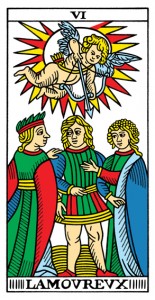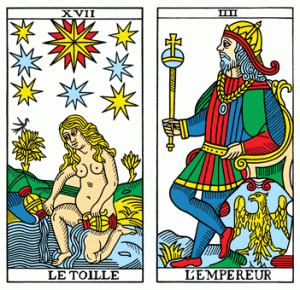In the open reading approach, the meaning of a Tarot card is what we see in its illustration when we do the actual reading. This means that there is no point in memorizing “the meaning of each card” beforehand. In other words, a Tarot card is not a symbol with some fixed meaning that we should retrieve from our memory when we see it in the reading. Instead, it is a visual tool that stimulates our perception and brings up messages from the unconscious part of our mind when we look at it.
Of course, previous knowledge about the cards is useful. The card illustrations are complex and tricky. There are many things in them that we don’t notice on first sight, and a good acquaintance with the card details can guide our attention towards them. Also, the symbols in the cards are charged with cultural, philosophical, and mythological meanings. Knowledge about these symbols and their significance, whether in general culture or in different schools of Tarot reading, can suggest a wide range of associations when we look at a card. But all this prior knowledge should not limit our ability to see the cards in a fresh perspective each time, and to let them lead us in new and unexpected directions.
The important point here is that the cards are a visual tool that works directly on the unconscious layers of our mind. In looking at the cards, what we see reflects what we feel deep inside. But the visual impression that the card makes on us will be different each time. Therefore, the meaning of the card cannot be fixed once and for all. Rather, the visual appearance of a card depends on the whole context of the reading.
Several factors contribute to this difference in visual impression. First, the card looks different when other cards are placed beside it. Second, The querent’s presence and his query have an emotional effect on us, which influences our ability to see certain things in the card and ignore others. Third, we are also not the same. We come to each reading with a different life experience, and in a different emotional state.
To be sure, the fact that the card meaning changes each time does not mean that we shouldn’t trust the message that we see in it. As discussed in chapter 2, in each card reading, everything is a sign. This includes not only the choice of cards in the spread, but also the fact that this querent chose to come to us at this particular moment. In other words, it is possible that the querent would get a similar answer from a different reader working with different methods. But in such a case, the shuffling would also be different and the answer would come from his looking at different cards. The cards, so to speak, tune themselves to the general context of the reading, including the previous knowledge and the emotional state that we bring into it.
Even in the course of the same reading our vision of the card can develop. We may give a certain interpretation to a card at the beginning of the reading, and later on in the same session arrive at another, deeper and more focused one. We can also see in the same cards a number of parallel stories or parallel layers of a story. In other words, even at a single moment in the reading a card can have more than one valid meaning.
My mentor, Jodorowsky, helped me understand this important lesson a few years ago when I visited him in Paris. I asked him about the symbolic meaning of various details in the deck he had published with Philippe Camoin. “No problem, Yoav,”’ he said. “Anything that you ask me, I will tell you. But if you ask me again next week, maybe I will tell you something different.”
It is important to understand this in the context of this book as well. This is why in the next chapters there may appear to be different interpretations for each card or image detail. The interpretations in the book are possible hints and suggestions that you can follow. But they should serve only as a starting point, and not block you from finding your own way. Looking at a card, it can also happen that you have an unexpected insight that is completely original, different from anything you have learned before. Such a spontaneous interpretation, which emerges in the middle of a reading, often turns out to be the most emotionally charged element in the session.
Here are two examples of such spontaneous interpretations which particularly impressed me. A young man had difficulties in his relationship with his girlfriend, and wanted to know where would it all lead. The main card which drew my attention was The Lover.

The common interpretations of the card speak of love or choice. But when I looked at the figure of the man between the two women, one younger and the other older, I felt that the card presented an image of the relationship itself. Often we can see in the card a man who is in a complex relationship with his female partner on the one hand, and with his mother on the other hand. But something in the querent’s presence made me approach the image from a slightly different direction. Instead of concentrating on the relationship between the querent and his own mother, I asked him what was happening between him and the girl’s mother. His answer was that indeed there was some flirting going on between them, and this caused tensions and quarrels in his relationship with her daughter.
In another instance a woman querent told me about the difficulties she was experiencing in different aspects of her life, including her relationships with men. Two cards which appeared side by side attracted my attention: The Star followed by The Emperor to its right.

Usually, The Star is regarded as an expression of sincerity, purity, and innocence, while The Emperor represents a strong and protective figure. But at that particular moment I felt something sinister in the picture of an overpowering man waving his masculine-looking club over a naked and cramped woman. In such matters one should be delicate enough not to pose a direct question, but I threw a hint in the air. The querent caught it and told me that she had been sexually assaulted by a relative at a young age, and had never spoken about it since.
Once such a spontaneous interpretation appears, it becomes a part of our collection of tools for future readings. But we should also be careful not to become too attached to it. We should not think of a sexual assault every time we see this card combination. One can see completely different stories in the combination of the same cards. For example, it can represent a woman that allows herself to be exposed and vulnerable because of the protective and confidence-inspiring presence of her partner. But as we shall see in the next chapter, the gender roles can also be reversed – that is, the masculine figures in the cards may also represent women in real life, and vice versa.